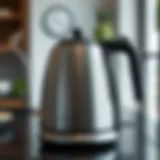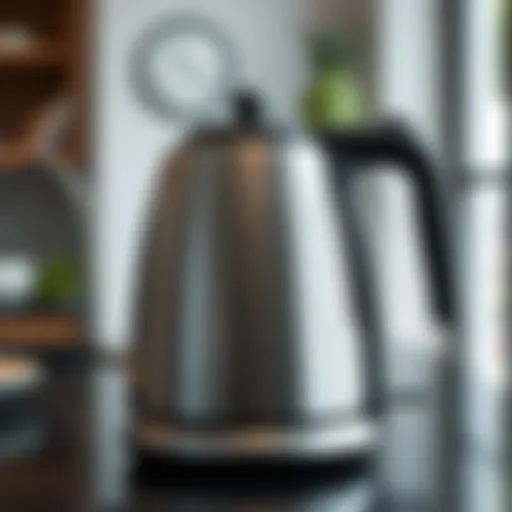Wood Cabinets for Sale: Design and Functionality Insights


Intro
In the world of home design, wood cabinets play a pivotal role in aesthetics and functionality. From kitchens to bathrooms, the choice of cabinetry can elevate the overall look of a space. Homeowners and designers alike find themselves wading through a vast array of styles, finishes, and pricing points. This guide aims to shed light on the myriad aspects of wood cabinets. It will guide you through the current trends and timeless styles. Additionally, we'll delve into practical care tips and sustainable options for your cabinetry.
Understanding how to navigate the market for wood cabinets is essential, whether you're a seasoned designer or a first-time homeowner. With the right knowledge, you'll be empowered to make choices that not only enhance your space but also reflect your personal style and values.
Let’s dive deeper into furniture styles and trends, and how they impact your cabinetry decisions.
Furniture Styles and Trends
Cabinetry is not just about storage; it's an expression of your taste. Different styles can impart distinct feels to your home. Understanding these styles can help you make informed choices.
Modern vs. Traditional: Understanding the Aesthetics
The debate between modern and traditional cabinetry is ongoing. Modern cabinets often feature clean lines and minimal ornamentation, making them ideal for contemporary spaces. They are typically crafted from materials like plywood with sleek finishes. More open layouts complement these styles effectively.
On the other hand, traditional cabinetry exudes warmth and charm. They often showcase rich wood textures, intricate carvings, and deeper hues. These cabinets can create a cozy atmosphere and work well in more classic or rustic interiors.
Key Features of Each Style:
- Modern Cabinets:
- Traditional Cabinets:
- Simplicity in design
- Functional materials
- Neutral color palettes
- Rich wood grains
- Detailed craftsmanship
- Warm, inviting colors
Choosing between these styles largely depends on personal taste and the desired ambiance of the space. However, it’s not uncommon for designers to blend elements from both styles to create something unique.
Color and Material Trends: What's In and What's Out
The finish of wood cabinets has evolved significantly. Natural wood tones are currently making a comeback, with homeowners leaning towards lighter shades like ash and maple. These hues brighten up spaces and give an airy feel. Darker woods like walnut and mahogany remain timeless choices, offering elegance and sophistication.
When it comes to materials, solid wood remains a top choice for durability and aesthetic. However, engineered woods like MDF are gaining traction for their cost-effectiveness and sustainability.
Currently Trending:
- Matte finishes over glossy
- Two-tone cabinets for added visual interest
- Eco-friendly materials
As we see a shift towards sustainability, more manufacturers are focusing on eco-friendly practices. Choosing cabinets that use reclaimed wood or sustainable forestry products not only supports the environment but also adds character to your home.
"Investing in high-quality wood cabinets can be a valuable addition to both the function and style of your home."
In capturing the essence of wood cabinets, it’s crucial to remain aware and selective about trends while still prioritizing function and sustainability.
Furniture Care and Maintenance
Once you've chosen the perfect wood cabinets, maintaining their beauty is equally important. Here are practical tips and ideas to ensure your cabinetry lasts long and looks fabulous.
Tips for Prolonging the Life of Your Furniture
Keeping your wood cabinets in top shape takes effort, but the results are worth it. Here are some straightforward maintenance tips:
- Regular Dusting: Use a soft cloth to regularly remove dust. This prevents buildup that can damage the finish.
- Use Gentle Cleaners: Avoid harsh chemicals. A mild soap solution can clean without stripping the finish.
- Humidity Management: Wood can expand and contract with humidity changes. Maintain a consistent indoor climate to prevent warping.
DIY Repair Hacks for Common Furniture Issues
Even the best wood cabinets might face a few bumps along the way. Here are simple DIY fixes:
- Minor Scratches: A simple solution of olive oil and vinegar can help reduce the appearance of scratches.
- Loose Hinges: Tightening screws can solve many issues with hinges and knobs.
- Water Stains: A paste of baking soda and water can often lift water stains off finished wood surfaces.
Regular care and timely repairs will maintain both the look and function of your wood cabinets. Choosing the right design, material, and maintenance habits means your cabinets will enhance your home for years to come.
By thoughtfully selecting and caring for wood cabinets, you ensure a harmonious blend of beauty and practicality in your space.
Prolusion to Wood Cabinets
When it comes to home design, particularly the kitchen and bathroom, wood cabinets often take center stage. Their versatility, aesthetic appeal, and functional benefits make them a cornerstone in cabinetry choices. This section aims to present a comprehensive overview of wood cabinets, elucidating their significance in both domestic settings and the broader industry of interior design.
Wood cabinets are more than mere storage solutions. They embody the style and character of a home. Whether you’re outfitting a new property or renovating an older one, understanding what wood cabinets offer is crucial. The warmth of natural wood can transform a cold, clinical space into one that feels inviting and lived-in. By diving into various types of wood, styles, and finishes, we can better appreciate why homeowners, designers, and retailers gravitate towards wood cabinetry.
Understanding the Appeal of Wood Cabinets
The allure of wood cabinets lies primarily in their natural beauty and timeless charm. With a spectrum of colors, grains, and textures, they can harmoniously blend into virtually any decor theme. From the rich, dark hues of cherry wood to the light, airy feel of maple, wood cabinets present an array of options to suit individual tastes.
Aside from aesthetics, wood cabinets offer durability and longevity. Unlike materials that may warp or chip, well-crafted wood cabinets can stand the test of time, making them a wise investment. Their inherent strength means that homeowners can rely on them for both everyday living and high-traffic areas.
Moreover, there’s an undeniable sense of tradition associated with wood cabinetry. It evokes a sense of nostalgia, often reminding individuals of family gatherings around a dining table or cozy evenings spent in a warm, wooden-finished kitchen. This emotional connection makes wood cabinets more than just functional furniture; they are part of one’s history and memories.
In addition to aesthetic and functional considerations, wood cabinets often offer customization options. Homeowners can choose specific wood species, finishes, and hardware to create a truly unique piece tailored to their space. This flexibility further enhances their appeal, allowing for personal expression in what is arguably one of the most essential spaces in the home.
A Brief History of Wood Cabinets
Wood cabinets have a long-standing history that can be traced back to ancient civilizations. In fact, the use of wooden furnishings dates back to ancient Egypt, where artisans crafted intricate wooden storage solutions. The methods and styles grew more advanced throughout the ages, reflecting broader societal shifts and technological advancements.
As we stepped into the Middle Ages, wood cabinetry began to take on more complex forms, often showcasing detailed craftsmanship. The rise of the Renaissance introduced innovative techniques, leading to the creation of not only functional storage but also pieces that served as works of art.
In more recent times, the 18th and 19th centuries saw a surge in the popularity of wooden cabinetry in Western homes. The Industrial Revolution brought mass production, making cabinets more accessible to a wider audience. Today, the craft has evolved further, marrying traditional practices with modern technology to produce cabinets that satisfy contemporary home needs.
This historical context is essential to understanding today’s wood cabinets. Each piece reflects a story, a journey from ancient craftsmanship to modern innovation. That rich history adds weight to the decision-making process for potential buyers, reminding them that they are investing in more than just physical items.
"The cabinet is not merely a storage solution, but a testament to artistry and functional design."
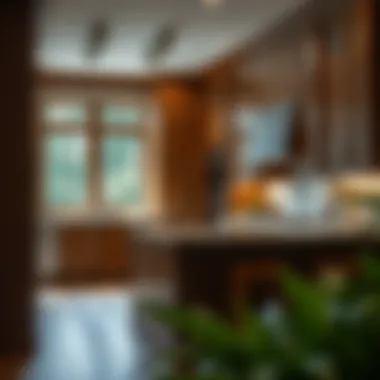

As we explore the full spectrum of wood cabinets in subsequent sections, it becomes clear that choosing wood cabinetry encompasses aesthetics, functionality, personal history, and even sustainability. This introduction lays the groundwork for a deeper understanding of what wood cabinets can bring to a home.
Types of Wood Used in Cabinetry
In the realm of cabinetry, the selection of wood species plays a crucial role, affecting not только the aesthetics of a space but also its durability and functionality. Each type of wood brings its unique characteristics, which can greatly influence the overall appeal and longevity of cabinets. Understanding the different types of wood used in cabinetry helps homeowners and designers make informed choices, ensuring the selected materials align with their desired style and practical needs.
When you're sifting through wood options, two primary categories come to light: hardwoods and softwoods.
Let's break them down.
Hardwoods vs. Softwoods
Hardwoods are derived from deciduous trees that lose their leaves annually. Common examples include oak, maple, cherry, and hickory. These woods tend to be denser and stronger, making them ideal for cabinetry. They offer a range of colors and grain patterns, which adds depth to any design scheme. Hardwoods, however, come with a price tag that typically reflects their quality and durability.
On the flip side, softwoods come from coniferous trees, including pine and fir, which remain evergreen. While softwoods are generally less expensive and easier to work with, they are not as sturdy as hardwoods. Yet, this doesn't mean softwoods should be discounted entirely. They can provide a lighter appearance and are often favored in rustic or casual designs.
Choosing between hardwoods and softwoods ultimately boils down to your personal taste, budget, and intended usage. For high-traffic areas where durability is paramount, hardwoods are likely your best bet. If charm and affordability are more what you're after, then considering softwoods may strike the right chord.
Common Wood Species Used in Cabinets
Oak
One of the stalwarts of cabinetry is oak. Boasting great strength and durability, oak stands out as a popular choice among homeowners and builders alike. Its characteristic grain pattern provides a stunning visual, often associated with traditional and transitional decor. Oak can be finished in various stains, revealing its natural beauty while allowing for customization.
A unique feature of oak is its resistance to wear and tear, making it a beneficial option for kitchen cabinetry. However, it can sometimes be susceptible to moisture if not properly sealed, which leads to consideration in areas of high humidity.
Maple
Maple is another heavyweight, known for its smooth surface and fine texture. It carries a neutral tone that can fit seamlessly into both contemporary and traditional designs. With excellent hardness and durability, maple cabinets withstand daily use while remaining visually appealing.
The light color of maple, however, can be both an advantage and disadvantage. While it brightens spaces, it can stain more easily than darker woods, necessitating careful maintenance to keep its appearance pristine.
Cherry
When it comes to elegance, cherry wood reigns supreme. This wood shines with its rich, warm hue that deepens over time, lending a sophisticated flair to any cabinet design. Homeowners are often drawn to cherry for its natural beauty, making it an excellent addition to refined spaces.
However, cherry is softer than oak and maple, making it less ideal for high-use environments. It scratches more easily, which can be a point of contention for families with children or pets.
Hickory
Last, but certainly not least, hickory offers a unique blend of strength and striking grain patterns. It’s known for being one of the hardest domestic woods and is favored for its durability, making it suitable for high-traffic cabinets. Hickory's distinct color variations range from light to dark, adding depth and flavor to any cabinet design.
That said, hickory cabinets may require more care during installation due to their density. Additionally, the wide color variations can be a personal choice; some homeowners might find it too busy for their liking.
Choosing the right wood species for your cabinets is not a decision to be taken lightly. Each type of wood offers its benefits and challenges, tailoring them to different needs and preferences. Whether you're after durability, aesthetic appeal, or cost efficiency, understanding the characteristics of these common wood species sets the stage for creating a stunning and functional cabinetry solution.
Styles of Wood Cabinets
The choice of cabinet style can significantly alter the ambience and functionality of a space. Understanding the different styles of wood cabinets not only helps you make informed decisions but also aligns with your personal aesthetics and practical needs in home design. A wood cabinet is more than just a storage solution; it's a statement piece that can reflect your taste and complement the overall design theme of your home.
Traditional Wood Cabinets
Traditional wood cabinets draw heavily from historical designs, often characterized by intricate details and craftsmanship. These cabinets typically employ rich, dark stains that showcase the natural grain of the wood, which adds to their classic feel. The elegant molding, recessed panels, and ornate hardware serve to enhance their timeless appeal.
When you opt for traditional wood cabinets, you're not just investing in furniture; you’re weaving a narrative of heritage into your home. They often pair well with luxurious or vintage decor, enhancing the warmth and character of spaces such as dining rooms and formal kitchens. These cabinets are best suited for homeowners looking to add a touch of sophistication and continuity with classic design elements. They make a solid foundation for a classic aesthetic while providing ample storage space.
"Traditional wood cabinets serve as a bridge between historical elegance and modern functionality, creating a seamless blend of old-world charm with everyday convenience."
Contemporary Wood Cabinets
Contemporary wood cabinets break away from conventional styles, focusing on clean lines, minimalist designs, and bold colors. These cabinets are often made from lighter woods such as ash or birch, with finishes that either highlight or obscure the wood grain. Instead of intricate details, they feature sleek designs that cater to modern sensibilities.
The beauty of contemporary cabinets lies in their versatility. They can seamlessly fit into various environments, from urban lofts to coastal homes. By incorporating elements like open shelving or unique hardware, these cabinets not only serve their purpose but also act as a focal point in kitchens and living rooms alike. Homeowners who appreciate a fresh, uncluttered look may find contemporary wood cabinets suitable for their lifestyles, paving the way for innovative space solutions.
Rustic Wood Cabinets
Rustic wood cabinets embody a sense of warmth and homeliness that speaks to natural beauty. Often constructed from reclaimed or distressed wood, these cabinets showcase imperfections that tell a story. The raw finish may include knots and variations that contribute to their character. If you imagine a cozy cabin in the woods, that’s the spirit these cabinets capture.
Rustic cabinets are perfect for those aiming to create a relaxed, organic atmosphere in their homes. They are excellent for farmhouse-style kitchens, dens, or any space that intends to promote comfort and connection with nature. The natural hues and textures encourage an inviting environment, making rustic cabinets a popular choice among homeowners who cherish simplicity and authenticity in their designs.
In summary, the choice of style in wood cabinets can immensely influence the feel and practicality of your space. Whether you lean towards the elegance of traditional designs, the minimalism of contemporary styles, or the warmth of rustic aesthetics, understanding these options allows you to tailor your living environment to your vision.
Finish Options for Wood Cabinets
When it comes to wood cabinets, the finish can make or break the overall aesthetic appeal and functionality. Choosing the right finish is not solely about the look; it serves practical purposes too. A well-chosen finish enhances the durability of cabinetry, making it resistant to wear and tear, and it protects the wood from various environmental factors. Moreover, the finish can highlight the natural grain of the wood, bringing out its character while complementing the space in which it resides.
In this section, we will dive into the two key types of finishes for wood cabinets: stains and paints, as well as the allure of natural finishes. Each has its own unique set of benefits and considerations to keep in mind during your selection process.
Stains and Paints
Stains and paints are often the first things that come to mind when discussing finishes. Both options serve different purposes and can dramatically alter the look of your cabinets.
- Stains penetrate the wood, allowing the natural grain to show through while adding color. They come in various shades, enabling a customization process that can match any design style, be it modern or rustic. It's crucial to note that stains can enhance the wood’s natural texture, making it look richer and deeper.
- Paints, on the other hand, provide a more uniform look, blocking much of the wood grain while offering an array of colors. This option is particularly popular in contemporary designs, where bold colors can make a striking statement.
When selecting between stains and paints, consider the following:
- Desired look: Are you aiming for a more natural appearance or a colorful finish?
- Maintenance: Paint generally requires more upkeep to maintain its fresh appearance than stains.
- Durability: Although both can be durable, stains may show wear faster than high-quality paint, especially if cabinets experience a lot of use.
"The right finish can elevate your cabinetry from being functional to becoming a work of art in your home."
Natural Finishes
Natural finishes are becoming increasingly popular among homeowners and designers alike due to their eco-friendliness and ability to showcase the wood’s innate beauty. These finishes typically include oils and waxes that provide minimal alteration to the wood’s original appearance. They are favored for their ability to maintain the natural character of the wood while adding protection against moisture and dirt.
- Oil finishes soak into the wood, enhancing its grain while also adding a soft luster that enhances the overall beauty. Products like tung oil or linseed oil are common choices.
- Waxes offer a low-sheen appearance and can be buffed for a polished finish. They are easy to apply and can be reapplied without much hassle, making them an ideal choice for those looking for lower maintenance options.
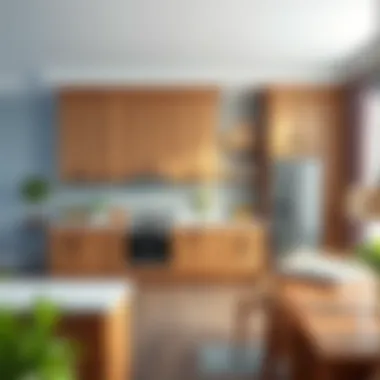

When considering natural finishes, keep in mind factors such as:
- Application complexity: Some natural finishes may require higher skill for application compared to stains or paints.
- Longevity: Although beautiful, natural finishes may not offer the same level of durability as synthetic options.
- Environmental impact: If sustainability is important to you, natural finishes are generally less harmful to the environment than conventional paints and stains.
In essence, the choice of finish can dictate the overall ambiance and longevity of your wood cabinets. By weighing the pros and cons of stains, paints, and natural finishes, you can make an informed decision that suits your style and maintenance preferences.
Factors Affecting Cabinet Pricing
Understanding what influences cabinet pricing is essential for anyone looking to make a purchase. This section will cover several key elements: the quality of wood, the construction methods used, and the various customization options available.
Quality of Wood
The quality of wood plays a pivotal role in determining the price of cabinets. Differentiating between hardwoods and softwoods is crucial here. Hardwoods, such as oak and maple, typically command higher prices due to their durability and aesthetic appeal. For example, oak cabinets are not only strong but also resist scratches and dents better than many softer varieties.
On the other hand, softwoods like pine and cedar can be more affordable but often don’t hold up under heavy use as well. They might be lighter on the wallet but might also require more frequent maintenance or replacement.
"Choosing the right wood is like picking a companion; you want something that will stand the test of time."
For homeowners, selecting the right quality is less about immediate cost and more about investment in longevity. If you plan on staying in your home for years, a higher upfront cost for better quality wood could save you cash in the long run.
Cabinet Construction
Cabinet construction methods significantly influence pricing as well. The craft that goes into constructing cabinets can make a world of difference. Features like joinery types, thickness of materials, and the overall finish affect not just durability but appearance.
Typically, cabinets that are made through traditional construction methods, such as solid wood or plywood with dovetail joints, tend to be pricier. In contrast, those assembled with particleboard and simpler joinery may be cheaper, but they often compromise on quality.
Here are a few types of common cabinet construction:
- Framed: More traditional, with a frame around the front edges for added stability.
- Frame-less: Offers a modern look and easier access to the interior space but can be less sturdy than framed options.
- Custom-built: Tailored to specific dimensions and styles, usually at a premium price.
In summary, understanding the nuances of cabinet construction can help in making informed decisions that marry budget and quality effectively.
Customization Options
Customization is another factor that can push cabinet prices up. The more tailored your cabinets are, the higher the cost is likely to be. Customization can't be overlooked when weighing your options, as it allows for personal constraints and aesthetics.
Here are various aspects you can customize:
- Finish Types: A matte or glossy finish can add varying price tags.
- Hardware Selections: Handles, knobs, and hinges can vary greatly in price, and opting for higher-end options might cost more.
- Dimensions: Unique sizes or shapes can also lead to higher pricing due to the custom work required.
Some may find that while custom options can be pricier, they also deliver the best fit and functionality for one's space.
Sourcing Wood Cabinets
Finding the right wood cabinets for your home is a bit like searching for a needle in a haystack; it takes time, thought, and a bit of elbow grease. The process is not just about aesthetics; it involves understanding where the cabinets come from, the quality of materials used, and how to find the best deal. Sourcing wood cabinets means more than just making a purchase—it's about aligning your choices with your values, style, and budget.
Retail Stores
When you opt to source wood cabinets from retail stores, you're stepping into a realm where touch and feel come into play. Whether it's a major home improvement chain like Home Depot or a specialized cabinetry store, visiting retail outlets has its perks. You can physically inspect the wood, feel its texture, and see firsthand the finishes that might work in your kitchen or bath. The benefit here is not just the visual; you can also consult with salespeople who are often knowledgeable about the differences between cabinet types, brands, and even current trends.
Keep an eye out for signage and promotions that might offer attractive deals. Additionally, many retail stores provide options for customizing your cabinets. You could select different wood types, stains, or hardware, which adds a personal touch to your space.
However, it’s worth noting that while retail stores provide immediate gratification in terms of selection and advice, they can sometimes carry higher prices due to overhead costs. Furthermore, store inventory may not always reflect the latest designs or sustainable practices, so it's smart to do some background research beforehand.
Online Marketplaces
In the digital age, online marketplaces have transformed the way we source wood cabinets. Websites like Etsy, Amazon, and Wayfair provide a plethora of options that might not be available in local stores. Through these platforms, you can find unique designs, often handmade by artisans, which adds a special flair to your home.
When sourcing from online marketplaces, you have the advantage of comparing prices and features from multiple sellers in a matter of clicks. Reviews play a crucial role here; they offer insights that can guide your purchasing decision. Be sure to look for seller ratings and customer feedback to gauge quality and service.
On the flip side, buying cabinets online can echo the age-old adage: "You can't judge a book by its cover." Without seeing the cabinet in person, it may be difficult to assess quality. Additionally, shipping costs could add up, and returning an item that's not what you expected can be a hassle. It’s crucial to read return policies before making a purchase.
"In sourcing wood cabinets, it’s about quality, value, and the craftsmanship behind each piece."
In summary, sourcing wood cabinets can significantly influence your construction or renovation project. By weighing the pros and cons of retail stores versus online marketplaces, you can make better-informed decisions that align with your design goals and budget. Understanding where to source your cabinets will set you on the right path towards creating your ideal space.
Sustainable Practices in Cabinet Manufacturing
As the awareness around environmental issues grows, many industries are adapting to sustainable practices. The cabinet manufacturing sector is no exception. Opting for sustainable practices not only aids in minimizing the environmental footprint but also appeals to homeowners seeking eco-friendly options. The future of cabinetry lies in its sustainability features, which encompass responsible sourcing of materials and eco-friendly finishes.
Responsible Sourcing of Materials
The journey towards eco-conscious cabinetry begins with the materials used in the manufacturing process. Responsible sourcing involves selecting wood from forests that are managed sustainably. This means ensuring that logging practices do not harm the overall ecosystem and that forests can regenerate naturally over time.
Many manufacturers now favor materials certified by organizations like the Forest Stewardship Council (FSC). Opting for FSC-certified wood ensures that the timber comes from responsibly managed forests, promoting conservation and enhancing local economies. In choosing products from these sources, consumers are not just purchasing cabinets; they are supporting sustainable forest management practices.
Some points to consider regarding responsible sourcing include:
- Transparency: Look for brands that disclose the origins of their materials. This adds to trust.
- Reclaimed Wood: Using reclaimed wood from old buildings or furniture is another sustainable choice. It reduces waste and breathing new life into materials.
- Local Sourcing: Purchasing from local suppliers can minimize transportation emissions and boost local economies.
Eco-Friendly Finishes
After the raw materials have been responsibly sourced, attention turns to the finishes applied to wood cabinets. Eco-friendly finishes are significant in ensuring that the final product does not release harmful chemicals into the air. Traditional finishes often contain volatile organic compounds (VOCs), which can trigger respiratory issues and contribute to atmospheric pollution.
When selecting cabinet finishes, consider:
- Water-Based Finishes: They contain fewer VOCs compared to oil-based products, making them a healthier choice for indoor air quality.
- Natural Oils and Waxes: These are derived from plant sources and provide a non-toxic way to protect wood while enhancing its natural beauty.
- Low- or No-VOC Paints: These options are widely available and provide good aesthetics while minimizing environmental impact.
"Choosing cabinets with eco-friendly finishes is not just a trend; it’s a wise investment in health and sustainability."
By opting for cabinets that adhere to sustainable practices in both sourcing and finishing, consumers not only contribute to a healthier planet but also enjoy high-quality products that stand the test of time. In the world of cabinetry, making environmentally conscious choices has never been more accessible, and manufacturers are stepping up to meet this demand.
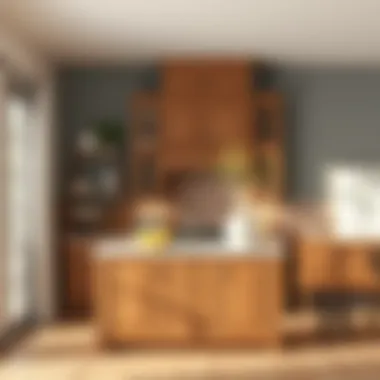

For further reading on sustainable forestry, visit the FSC website. Additional information on eco-friendly materials can be found at Green Building Advisor.
As you explore your options, keep sustainability in mind - after all, the choices you make today will echo into tomorrow.
Maintenance and Care for Wood Cabinets
Maintaining wood cabinets goes beyond just aesthetics; it's a vital component to ensure their longevity and functionality. Proper care not only preserves their appearance but also enhances their resilience against day-to-day wear and tear. Wood is a natural material, often impacted by environmental factors like humidity and temperature. By understanding and implementing maintenance strategies, homeowners can protect their investments and continue to enjoy the beauty of their wood cabinets.
Cleaning Techniques
When it comes to cleaning wood cabinets, the right approach can make all the difference. Here are some recommended techniques for keeping your cabinets looking brand new:
- Choose the Right Cleaners: Use a mild soap solution or a cleaner specifically made for wood. Avoid harsh chemicals that can strip the finish.
- Soft Cloths are Key: Microfiber cloths are gentle and effective. They won't scratch the surface, making them ideal for regular cleaning.
- Spot Cleaning: For stains and spills, act quickly! Wipe them up with a damp cloth, then dry immediately to prevent water damage.
- Dust Regularly: Build-up of dust can abrade the finish. A quick dusting every week or two helps maintain luster.
"Regular upkeep can add years to the life of your cabinets."
Cleaning wood cabinets should be part of your broader household cleaning routine, but don't be overly zealous. Gentle, consistent attention will result in a gracious patina that celebrates the wood's natural beauty over time.
Preventing Damage
A proactive approach to preventing damage can save you time and money in the long run. Here are several strategies to safeguard your wood cabinets:
- Mind the Humidity: Wood expands and contracts with changes in moisture levels. A dehumidifier can help maintain stable conditions, especially in kitchens and bathrooms.
- Avoid Direct Sunlight: UV rays can fade finishes and wood grain patterns. Consider using window treatments or positioning cabinets away from direct sunlight.
- Handle with Care: Always use handles when opening and closing cabinet doors. Pulling directly on the door can loosen the hinges and disturb alignment.
- Choose the Right Location: Avoid placing cabinets near heat sources, such as radiators or stoves, which can cause warping or cracking over time.
By taking some simple yet effective steps, you can significantly extend the life span of your wood cabinets. Remember that consistency in care will lead to durable beauty that withstands the test of time.
Trends in Cabinet Design
In recent years, the world of cabinetry has seen a dynamic shift, driven by both aesthetic desires and functional needs. Trends in cabinet design are crucial for homeowners, designers, and retailers to stay ahead in a competitive market. It's not just about furniture; it's about a lifestyle and an expression of one’s personality through choices made in the kitchen, bathroom, or any space that showcases wood cabinets. The right design can enhance a home’s value and reflect modern sensibilities.
Minimalism and Functionality
Minimalism in cabinetry focuses on clean lines, simplicity, and sparse decoration, appealing to those who desire a clutter-free environment. This style resonates with the philosophy of 'less is more,' emphasizing functionality without sacrificing elegance. Homeowners today are prioritizing efficiency in their spaces, leading to a rising demand for designs that enhance utility.
A few concepts to consider:
- Integrated Handles: Cabinets now come with flush or integrated handles, seamlessly continuing the cabinetry's sleek lines.
- Open Shelving: This trend not only opens up the space visually but also promotes easy access to frequently used items, fostering a more organized and efficient environment.
- Neutral Colors: Whites, grays, and blacks dominate minimalistic designs, creating an understated elegance that can complement any decor.
Also, think about how minimalism can translate to improved maintenance. Fewer decorative elements mean less dusting and cleaning, making it easier to keep spaces looking neat in the long run.
Smart Cabinet Solutions
As technology seeps into every corner of our lives, cabinetry is not left behind. Smart cabinet solutions come into play, offering functionalities that cater to the tech-savvy homeowner. In a world where automation is becoming the norm, smart cabinets can increase both efficiency and convenience.
Key elements of this trend include:
- Sensor-Activated Lighting: Lights that turn on when a door is opened create both drama and practicality, allowing easy visibility inside cabinets without fumbling around in the dark.
- Pull-Out Organizers: These maximize space and make even the smallest of kitchens feel bigger. They allow easy access to pots, pans, and pantry items, optimizing the stock and flow.
- Smart Features Integration: Imagine a cabinet that can tell you when you’re running low on a staple. Integrating IoT technology into cabinets not only adds convenience but also opens doors to innovative designs.
In a rapidly evolving design landscape, integrating smart solutions is no longer just a luxury; it's fast becoming a necessity for modern households.
The movement towards minimalism and smart cabinet solutions is reshaping the landscape of cabinetry. For homeowners and designers, understanding and implementing these trends means meeting the needs of today’s lifestyles while enhancing the aesthetic appeal of residential and commercial spaces.
Finally, it is crucial to recognize that each trend brings its challenges. Balancing aesthetics with practicality requires careful planning and an understanding of both materials and technology to create cabinets that are as functional as they are beautiful.
DIY vs. Professional Installation
Choosing between DIY installation and hiring a professional is a pivotal decision when considering wood cabinets. This choice can greatly influence not just the aesthetics of your space, but also its functionality and your overall satisfaction with the project. Understanding the nuances of both approaches helps homeowners, designers, and enthusiasts make informed choices that align with their specific situations.
Assessing Your Skill Level
Before diving headfirst into a DIY project, it’s crucial to take stock of your own skills. Woodworking isn't just about having the right tools; it also demands a fair share of know-how. If your experience with power tools is limited to assembling furniture from flat-pack boxes, you might want to reconsider.
Self-assessment can look something like this:
- Previous Experience: Have you ever built or installed something similar? Building a birdhouse at summer camp doesn't quite measure up to installing kitchen cabinets.
- Tool Proficiency: Do you know how to properly handle drills, saws, or levels? Familiarity with these tools reduces errors in measurements and alignments.
- Problem-Solving Skills: DIY jobs often come with unexpected hiccups. Think about how comfortable you are troubleshooting and adapting.
If you're feeling confident and maybe even a bit adventurous, you could give it a whirl. If not, it might be worth your while to hire someone who knows their stuff.
Cost Considerations
When it comes to installation, costs can vary wildly between DIY and professional installation. Doing it yourself can seem like a good way to pinch pennies. However, it can quickly turn from a cost-saving endeavor into a wallet-draining exercise if mishaps occur.
Here’s a breakdown of the financial aspects to consider:
- Material Costs: Whether you go the DIY route or hire a pro, the raw materials remain constant. Quality wood cabinets will demand a fair price no matter how they're installed.
- Tool Expenses: If you’re opting for DIY, consider the tools you might need to purchase or rent.
- Time is Money: Every hour spent on installation is time not spent on other tasks. DIY can take longer—especially if you're learning as you go.
- Potential Mistakes: Inadequate skills might lead to costly mistakes, requiring you to either redo work or hire a professional at a later stage.
Be sure to weigh the potential savings against these factors. In some cases, hiring a professional may actually end up being the more economical choice when you factor in time and labor considerations.
Remember: Choosing the right installation method has lasting effects. It’s not just about getting cabinets up on the wall, but doing them correctly and stylishly.
Ultimately, whether you decide to tackle the project solo or turn the reins over to an expert, understanding your own capabilities, the costs involved, and the implications on your living space is paramount. Making this decision with care can save time, money, and frustration in the long run.
End
The conclusion of this comprehensive guide serves as a pivotal reflection on the multifaceted world of wood cabinets. In today’s market, the right cabinetry extends beyond aesthetics, playing a vital role in enhancing functionality and overall home value. While making choices about wood cabinets, one must consider critical elements such as the type of wood, finish, and style that effectively match both personal taste and practical needs.
Recap of Key Points
- Diverse Wood Types: Understanding the differences between hardwoods and softwoods is essential for determining durability and style. Common options like oak, maple, and cherry each bring a unique character to cabinetry.
- Variety of Styles: Whether leaning towards a rustic look or a contemporary design, various styles are available to meet different design philosophies.
- Finishing Options: The choice of finish impacts both the visual appeal and the longevity of the cabinets. From stains to eco-friendly finishes, selecting the right option is crucial.
- Pricing Factors: The cost of cabinets can vary significantly based on wood quality, construction techniques, and custom capabilities. It is important to balance budget with quality.
- Sustainability Analytics: A growing trend highlights the importance of eco-friendly practices in sourcing and manufacturing cabinets, making it easier to align personal choices with environmental values.
Final Thoughts on Wood Cabinets
Wood cabinets represent not just a storage solution but a significant investment that influences the aesthetic and functionality of your home. Choosing cabinets made from quality materials can drastically change a room's ambiance while preserving durability over time.
Moreover, as trends evolve, homeowners should remain aware of how emerging design concepts—like minimalism and smart solutions—can fit into traditional cabinet styles. In summation, the world of wood cabinets is rich and varied, offering countless opportunities for those who seek to enhance their living spaces thoughtfully. Making informed decisions ensures that you choose cabinets that not only look good but also serve your needs effectively.
"Good cabinetry is meant to be both beautiful and functional, fostering a seamless blend of utility and design in your home."
As you embark on your cabinetry journey, remember that wood cabinets can be both a focal point of beauty and a cornerstone of practicality.




